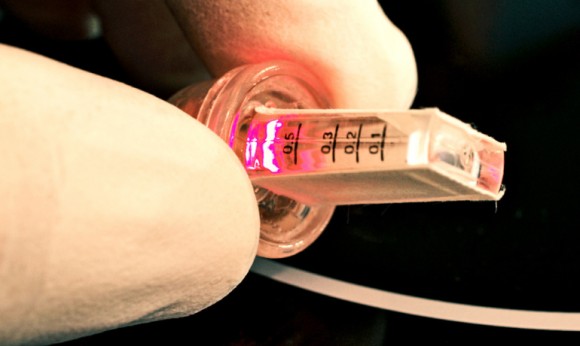
A research team has developed a new gene regulation method that lets thought-specific brainwaves control the conversion of genes into proteins — called gene expression. The bioengineers published their results in the journal Nature Communications on November 11, 2014.
Martin Fussenegger is professor of biotechnology and bioengineering in the department of biosystems at ETH Zurich, an engineering, science, technology, mathematics and management university in Switzerland. He wrote in a press release at Futurity.org:
For the first time, we have been able to tap into human brainwaves, transfer them wirelessly to a gene network, and regulate the expression of a gene depending on the type of thought.
Being able to control gene expression via the power of thought is a dream that we’ve been chasing for over a decade.
These scientists say one source of inspiration for the new thought-controlled gene regulation system was the game Mindflex, in which the player wears a special EEG headset, which has a sensor on the forehead that records brainwaves.
In the game, the registered electroencephalogram (EEG) is then transferred into the playing environment. The EEG controls a fan that enables a small ball to be thought-guided through an obstacle course.

In these scientists’ research, recorded brainwaves are analyzed and wirelessly transmitted via Bluetooth to a controller, which in turn controls a field generator that generates an electromagnetic field, which in turn supplies an implant with an induction current.
A light then literally goes on in the implant: an integrated LED lamp that emits light in the near-infrared range turns on and illuminates a culture chamber containing genetically modified cells. When the near-infrared light illuminates the cells, they start to produce the desired protein.
The implant was initially tested in cell cultures and mice, and controlled by the thoughts of various test subjects. The researchers used SEAP for the tests, an easy-to-detect human model protein which diffuses from the culture chamber of the implant into a mouse’s bloodstream.
To regulate the quantity of released protein, the test subjects were categorized according to three states of mind: bio-feedback, meditation, and concentration. Test subjects who played Minecraft on the computer, i.e. who were concentrating, induced average SEAP values in the bloodstream of the mice.
When completely relaxed (meditation), the researchers recorded very high SEAP values in the test animals.
For bio-feedback, the test subjects observed the LED light of the implant in the body of the mouse and were able to consciously switch the LED light on or off via the visual feedback. This in turn was reflected by the varying amounts of SEAP in the bloodstream of the mice. Fussenegger said:
Controlling genes in this way is completely new and is unique in its simplicity.
The scientists went on to say that the light-sensitive optogenetic module that reacts to near-infrared light is a particular advancement. The light shines on a modified light-sensitive protein within the gene-modified cells and triggers an artificial signal cascade, resulting in the production of SEAP.
Near-infrared light was used because it is generally not harmful to human cells, can penetrate deep into the tissue, and enables the function of the implant to be visually tracked.
The system functions efficiently and effectively in the human-cell culture and human-mouse system. Fussenegger hopes that a thought-controlled implant could one day help to combat neurological diseases, such as chronic headaches, back pain, and epilepsy, by detecting specific brainwaves at an early stage and triggering and controlling the creation of certain agents in the implant at exactly the right time.











